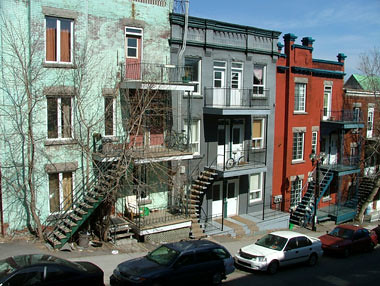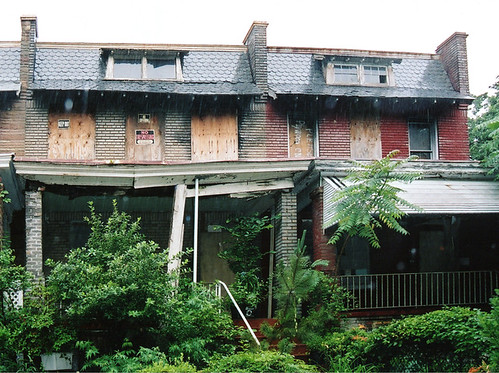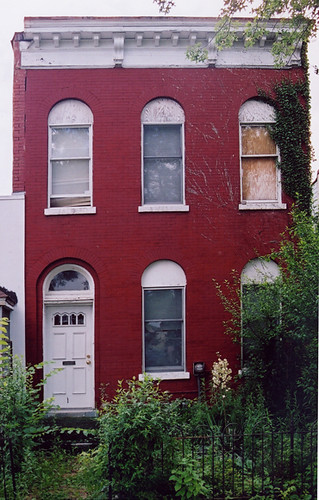Historic preservation is not the bogeyman for finding cheap apartments in DC
Today's Post has an article, "The new housing market: Why it’s so hard to find a cheap apartment in Washington, D.C.," with this line about strategies for producing more and lower cost housing:
In D.C., you could even ditch the large historic districts that make it extremely difficult to build anything substantial in many desirable neighborhoods.Too bad it's wrong. (The article doesn't say all that much considering.)
The reason that it's hard to find cheap apartments in DC, is that relative to demand, there is lack of inventory.
But it's not because of historic districcts.
It's because historically, DC had been a small city relatively speaking, and not an industrial city, which would have led to the construction of more and higher capacity apartment buildings and tenements.
Instead, especially in the late 1800s and into the early part of the 1900s, mostly single family housing (rowhouses) was constructed in those inner city neighborhoods that are now considered desirable.

Plexes in Montreal.
Compare that to cities like New York (tenements and "walkups"), Cleveland or Boston (three-story buildings with two or more apartments on each floor), and Montreal (plexes--three-story buildings constructed on the equivalent of two rowhouse lots, with 5-6 units total) where the focus was on constructing residential buildings with multiple apartment units.
And even in neighborhoods where there is a mix of apartment buildings and single family housing, like Dupont Circle or parts of Capitol Hill, Columbia Heights, etc., the apartment buildings aren't that big, limiting inventory.
This is the 300 block of East Capitol Street NE. Bigger buildings tended to be built near the Capitol and Downtown. When Congress met on a more limited basis, apartment living in the city was more common.
When demand is high and inventory is low, prices are high.
Personally, I think that neighborhoods with a mix of residential building types are more resilient.
... but getting back to the quoted piece, again, removing historic designation wouldn't all of a sudden yield "cheap apartments," because the issue is lack of apartments, not historic designation.
By definition, newly constructed apartments are priced at today's market rates, so prices are "high."

These "Wardman style" rowhouses at 1022 3rd Street NE were torn down in the mid-2000s in favor of a large multiunit apartment building. (The buildings were left to decay while the developer was assembling the block.)
This Queen Anne style rowhouse, dating probably to the 1890s, was at the southwest corner of 3rd and K Streets NE.

So if you were to tear down a bunch of houses, in this case, rowhouses that would be eligible for designation, but were not in a historic district, such as what was done on the 1000 block of 3rd Street NE, where a block of rowhouses were torn down to build the first phase of the Loree Grand apartment building on the 200 block of K Street NE, what is produced are new apartments constructed at current costs, which are priced at the high end of the market.

In 30 years or so, the prices will end up being lower relative to new construction. But that doesn't mean much to people today.
According to the Loree Grand website, rental rates for apartments range from about $1,500 for the smallest studios to not quite $4,414/month for a 1,318 s.f. unit. Prices are dependent on the size of the unit.
And this would be the case, if you were to tear down historic houses too, although prices would end up being even higher, because of the higher costs involved in assembling land.
Labels: historic preservation, housing choice, housing market, housing policy, multi-unit housing, real estate development, real estate market




15 Comments:
Great points, esp. on the 30 year curves that the market uses.
And of course, the same arguments apply to the height limit.
As I have said before, Section 8 creates an artifical floor on pricies of around 1500. Below that it is all voucher world rather than market based.
ADUs might change that, although I am not convinced that ADU are going to go into areas where people want to live.
And we we do better by forcing developers to build market rate smaller units for rent/sale rather than the complicated Affordable housing requirement based on income.
As always, a thoughtful post Richard. Thanks for writing.
That said, I disagree and would argue we need to take a more macro view of the impact of historic districts versus the micro Loree Grand example. I hypothesize that if you were to look at the housing economics (rental market, construction, renovation, etc) throughout the entire districts you would find things are more expensive.
To your point in this piece, supply and demand are very real forces - and there is no way one can argue that historic preservation doesn't restrict supply. Now, there is a definite cost/benefit argument that historic preservationists make for the restrictions but that is not what we are discussing.
Thanks for the post.
anon -- what I didn't write about is the difficulty of rezoning and assembling a large tract of land from rowhouses or other SFH--owner occupied housing.
It's very rare for SFH to be converted to high density housing, historic designation or not, because of the cost (not just in money, but in time and difficulty) of assembling the land.
I can think of an instance in Fairfax and a couple others, where the neighborhood banded together and sold out. But it's rare. (even in the face of Kelo...).
So it's a chimera to discuss this in terms of HP restricting supply.
2. Another example of course is what Arlington County did in the Wilson Blvd. corridor. They did rezone (not unlike how the federal government had purchase options on lots of land in SW DC which foatered the demolition of rowhouses there in favor of urban renewal) and over time the SFH that was there (like around Virginia Square, at least as of 1987) became decrepit because the owners knew it was gonna be purchased and rebuilt.
We could do that in DC. But politically I don't think it would fly. Owner occupied housing is very difficult to change.
3. the other thing I didn't write about is the wasted opportunities now.
The point about low density, etc., e.g., the apartments a few blocks from the now Takoma Metro that are all 2-3 story buildings, built that way in the 1940s or whenever. Just think if they had been a couple stories higher.
It's that way across the city.
And we are still screwing this up, e.g., the apartments within one block of Takoma Metro that are 4 stories.
There should be a mandatory density bonus within a couple blocks of Metro.
... but generally, 6-7 stories is the max anyway based on construction costs and methods. (Although there are some new developments with wood.)
charlie -- I think ADUs have legs, but again, for a particular segment of the market, depending on where they are built.
And it's not like it will revolutionize the market as it's just one element of the housing picture.
What, maybe 5000 - 10000 units could be built in the back of lots and 10000 or more units in houses.
And some people aren't gonna want to deal.
Our next door neighbors finished their basement and then let some friends stay there.
Thr tenancy has dragged out as certain options fell through. If you don't really want to share your lot with someone (Suzanne doesn't, although she's ok with VRBO.com for a detached ADU), well, that's an issue.
anyway, if we ever meet in person, I'll tell you about my ADU business concept... It has legs in DC especially and Seattle.
charlie -- one more thing, about your point about how to handle affordable housing. I don't know myself, but one of the things I have thought is that it needs to be managed in toto as a "single inventory" across properties.
But not by "the city".
I talked to David Mayhood about this once and I meant to follow up with an interview. (His company is one of the leading firms in the area marketing condos for the various developers.)
Like I said, the basic idea is that you pool all the units into one resource, with one system for prequalifying (for rent or purchase) etc.
Rather than going at it property by property which is a time sink and resource constraining.
(It's another example of my action planning concept, and integrating program delivery with ideation.)
Yes, I've often wondered if anyone in DC has a master list of every rental available.
It is another reason I don't believe the affordable housing lobbyists. We don't have an inventory. We have models, but not sure how useful.*
In terms of ADU, removing them from civil rights/landlord tenant protections is needed before they will every become useful. If they are subjected to the full onslaught, they will just be taken of the market and used privately or for something like AirBnB.
Reminds me of what happened to an ex-GF years ago when a unclassy room-mate came in, ex got the hell out, turns out there was not an actual lease on the 2BR for over 5+ years. Not atypical.
* and I have to wonder how much millenal griping about AH is just the massive decline of group houses in DC. When I moved here there were hundreds that you get for room in for about 150 a month. No market rate will ever duplicate that in a functioning city.
1. very good point about the landlor-tenant laws. That was pointed out to me as an issue for renting out upper stories in commercial districts like H St.
Many property owners didn't want to deal.
2. Yes, I think the group house thing is a big deal too. One is the reduction in inventory (again, they developed because of lack of demand...).
I didn't get selected but after my wife left me I looked at a group house on Maryland Ave. NE in a big house on the 300 block that was around $200/mo. in 1990.
The other might be that today's younger people are less inclined to be interested in living with other people/in a group house.
DK. I don't interact enough with that age cohort to get a sense of how they think on such an issue.
3. wrt your point about "master list." This came up with English basements in "historic districts" when I was contacted by a freelance writer doing a piece for the Friday section on rental housing in The Express.
I made the same point, that it's very difficult to get a handle on what's available.
Stashing 2 people in a 2BR (or three) is now far more common that group houses.
Better amenities, but price points come in at the 900 range.
Would be an interesting business model to put 4 or 6 mirounits around a kitchen/dining core. Having your own bathroom is a big deal. Throw in free cable...
A girl stopped me the other day and asked if people rented out units in my building. the answer is yes, about half are rented out, but in a year and a half I've seen one unit listed on CL or zillow. Rental turnover is high.
If I could talk up some Chinese investors, buying multiunit in DC and then ripping it down would be a very good business. The amount of stagnant investory is, well, staggering for a dynamic market.
While historic districts are only one limit on supply I am surprised at the need to, yet again, point out that even expensive new luxury housing has an impact on the rest of the market via filtering. DW and I just moved into a a circa 1990 "luxury" building in Alexandria. We did so because we were priced out of newer buildings in better parts of Alex, in closer in parts of Arlington, and in places like SW DC. Probably by people who were themselves priced out of places like Loree Grand - because supply of such places has not caught up to demand. In turn we probably took the place of someone who will end up going to a circa 1970s hirise in a less convenient part of Alexandria, South Arlington, southern FFX, etc.
This post is seriously flawed.
The argument is that old rowhouses were torn down and replaced with luxury apartments, and therefore not preserving those old rowhouses didn't result in affordable housing. What?
The rich folks are only going to live in one apartment. If they rent/buy the luxury apartment that replaced the old rowhouses, the same people aren't going to move into poor areas and buy/rehab/gentrify and reduce the stock of affordable housing.
PLUS... those row houses are single family homes. This handful of single family homes were replaced with dozens of apartment dwellings. Thus, the supply of housing stock has now increased dramatically, which should help reduce the cost of housing across the city.
The point is that not being able to tear down rowhouses isn't the reason there isn't cheap housing.
And that's one of the only examples we have to demonstrate the point, given that most other multiunit buildings have been constructed in commercial areas.
2. The reason that the new housing doesn't reduce housing costs "across the city" is because demand is much greater than the supply.
3. But as I wrote in an earlier comment, over a 30 year period or so it will have impact on housing cost.
no problem with filtering.
... but, the problem with "filtering" is that the high demand for multiunit housing, and the demand for owned housing has led to the conversion of a lot of class B and class C type buildings to owner occupied, so you lose the impact that filtering would normally have on rental housing.
One of the "problems" with keeping small buildings as rental is the scaling up of the property ownership market. They don't find "small" properties, say under 50 units, cost effective to operate and manage. That's why properties of this size tend to get converted to condos.
RL
In Va lots of class B and C buildings are quite large, and are rental. Anyway, I am not sure there isn't filtering across the rental/O-O divide though it presents different issues. I think the same is true of EOTR DC, and of Md. WOTR DC has a shrinking share of non-affluent people anyway.
well, you're talking about two meanings of filtering, price w/o regard to jurisdictional borders, and intrajurisdictional filtering, which is what I was writing about, even if I didn't make that very clear.
And yes, the residential market is cross-border for good and bad (e.g., marketing against DC).
2. wrt cross jurisdictional filtering, there is a piece in the Sunday Times about people being priced out of Brooklyan and now moving to places like "Queens" and Jersey City.
http://www.nytimes.com/2014/08/26/realestate/readers-respond-to-life-after-brooklyn.html?_r=0
Luxury Homes for Sale in Washington DC View Luxury Property Listings, Compare Prices and See Reviews with just One
Click See More just one click
Washington DC Condos for Sale
Post a Comment
<< Home